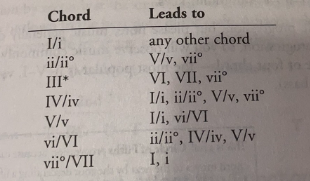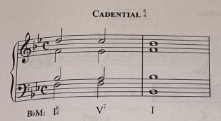
Chapter 9 - Harmonic Progression and Harmonizing a Melody
Harmonic Progression
Harmonic progression - The process of relating chords within the scale to where they naturally lead.
Progression - When the harmonies proceed from a stable beginning (tonic function), move forward through progressively more active chords (predominant and dominant function), including seventh chords to end (resolve) with stability.

Circle Progression
Circle progression - The movement of chords where the root of each chord is a diatonic fifth above the next chord.
Strongest motion in tonal music

The most common use of the vii° triad is in first inversion (vii°6) resolving to I or I6.

Progression by thirds - The movement of chords where the root of each chord is either up or down by a third.

Progression by seconds - The movement of chords where the root of each chord is either up or down to the next note in the scale.

How Does Inversion Affect the Function of a Chord in a Progression?
The more a chord is inverted, the weaker its function or the more it functions like another chord.
Types of second inversion chords
Passing
Pedal
Arpeggiated

Cadential

PROgression vs. RETROgression
RETROgression - When harmonies move backwards from this concept T-D-S-T (a root position V to a root position IV).
Don’t follow V with IV, ii6 or ii6/5.
Don’t follow vi (VI) with I (i) because the tonic chord is more stable, less tense than IV.
Don’t follow ii with IV. They’re not equal in tension.
Harmonic Rhythm
Harmonic rhythm - The rate at which harmony changes.
There’s no rules for this.
Fundamentals of Melodic Harmonization
The Process of Harmonizing a Melody
Identify the notes of the melody with either scale degree numbers or solfege.
Do the cadences first.
Cadences end with I (i), vi (VI) or V only, so the chord symbols at the fermatas should only be a I, vi or V (i, VI or V in minor).
Use root position chords for the final two chords in each of your cadences.
Use the same process used to create an implied progression from the bass line to create a viable progression that goes with the melody.
Don’t invert needlessly
Don’t use seventh chords excessively
Don’t use root-position vii° chords
Don’t use non-chord tones excessively in the bass line
Don’t use second inversion triads unless you understand the function
Identify any notes out of the key and what that implies.
Connect the dots between melodic patterns and implied harmonies.
Chapter 9 - Harmonic Progression and Harmonizing a Melody
Harmonic Progression
Harmonic progression - The process of relating chords within the scale to where they naturally lead.
Progression - When the harmonies proceed from a stable beginning (tonic function), move forward through progressively more active chords (predominant and dominant function), including seventh chords to end (resolve) with stability.

Circle Progression
Circle progression - The movement of chords where the root of each chord is a diatonic fifth above the next chord.
Strongest motion in tonal music

The most common use of the vii° triad is in first inversion (vii°6) resolving to I or I6.

Progression by thirds - The movement of chords where the root of each chord is either up or down by a third.

Progression by seconds - The movement of chords where the root of each chord is either up or down to the next note in the scale.

How Does Inversion Affect the Function of a Chord in a Progression?
The more a chord is inverted, the weaker its function or the more it functions like another chord.
Types of second inversion chords
Passing
Pedal
Arpeggiated

Cadential

PROgression vs. RETROgression
RETROgression - When harmonies move backwards from this concept T-D-S-T (a root position V to a root position IV).
Don’t follow V with IV, ii6 or ii6/5.
Don’t follow vi (VI) with I (i) because the tonic chord is more stable, less tense than IV.
Don’t follow ii with IV. They’re not equal in tension.
Harmonic Rhythm
Harmonic rhythm - The rate at which harmony changes.
There’s no rules for this.
Fundamentals of Melodic Harmonization
The Process of Harmonizing a Melody
Identify the notes of the melody with either scale degree numbers or solfege.
Do the cadences first.
Cadences end with I (i), vi (VI) or V only, so the chord symbols at the fermatas should only be a I, vi or V (i, VI or V in minor).
Use root position chords for the final two chords in each of your cadences.
Use the same process used to create an implied progression from the bass line to create a viable progression that goes with the melody.
Don’t invert needlessly
Don’t use seventh chords excessively
Don’t use root-position vii° chords
Don’t use non-chord tones excessively in the bass line
Don’t use second inversion triads unless you understand the function
Identify any notes out of the key and what that implies.
Connect the dots between melodic patterns and implied harmonies.
 Knowt
Knowt